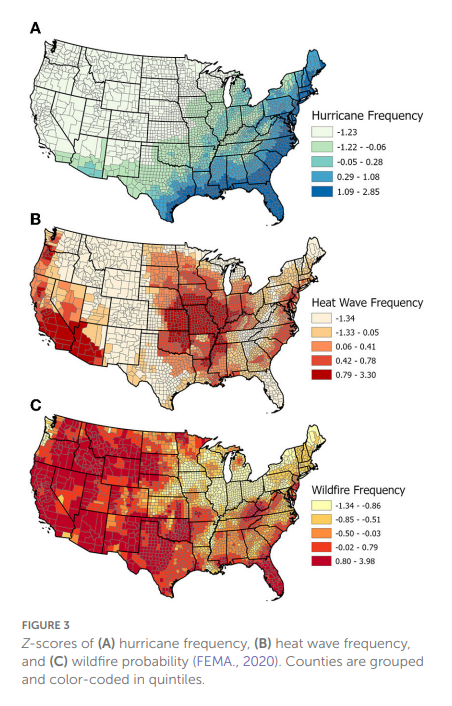Research into human migration shows distinct patterns, including the surprising trend toward areas affected by wildfires.
The effects of climate change are growing more frequent and noticeable. In the United States, temperatures have warmed by 1.2 degrees Fahrenheit since the 1960s. Within decades as much as 2.5 degrees Fahrenheit of additional warming is expected to occur.
Extreme weather events such as heat waves, hurricanes, and wildfires are also expected to increase. Such events have hugely detrimental effects on people’s lives. They destroy homes and livelihoods, causing dozens of deaths and billions of dollars of damage every year.
What role does the changing climate play in the decisions people make about where to live? A recent paper published in the journal Frontiers in Human Dynamics examined migration trends inside the United States related to environmental features, climate, and frequency of extreme weather events.
Where does migration occur?
The map below shows which areas in the country the largest number of people have moved to and from between 2010 and 2020. Red areas show where more people have moved into than out of. Blue areas show where more people have moved out of than into. This map was created using US Census data and geospatial information software.

Migration hot spots, where more people moved in than out, include large areas of the South and West. Major cities like Nashville and Atlanta saw an influx of people. So did large areas in the states of Florida and Texas. In the West, hot spots include large portions of Arizona and Nevada as well as the Pacific Northwest.
Migration cold spots, areas where more people moved out than in, are evident in the Great Plains region and along the Mississippi River. A large area of New York and West Virginia also saw a greater number of people leaving.
Where does extreme weather occur?
Examples of extreme weather events include wildfires, heat waves, flooding, and hurricanes. Below are some examples of where extreme weather events occur across the country.

Hurricanes usually land along the East and Gulf Coasts, ranging from Texas to Maine. Heat waves are most frequent throughout the Great Plains and along the Mississippi River. Wildfires dominate the West, where heavy smoke and evacuations are now routine during fire season.
Analysis of migration patterns in the US
Many variables affect a person’s decision to move to a new location. Researchers also considered the presence of natural amenities in the landscape and socioeconomic factors. Natural amenities include average temperatures, distance to bodies of water like lakes and rivers, and amount of forest cover. Socioeconomic factors include the number of job opportunities in a location, cost of living, population density, social services, crime rates, cultural norms, and gender relations.
Learn more about population density affecting the climate: Underground Climate Change Is Sinking Our Cities
After controlling for socioeconomic and environmental amenity factors, analysis showed that people have been moving away from US counties most affected by heat waves and hurricanes but toward those most affected by wildfires. They also moved towards more temperate areas in general, including cities with extremely hot summers. An influx of people into these urban areas increases the risk of health issues related to high temperatures. In rural areas, people moved away from high humidity and closer to high-amenity areas near bodies of water and more forest cover. This data is represented by the flowchart below.

Researchers note that “migration across urban and suburban areas is more heavily influenced by economic factors, while the natural landscape plays an elevated role in rural areas.”
Limitations and further study
The current study was able to control only for static demographic and socioeconomic characteristics at the county level. Further research should examine the variation in migration patterns of people of different ages, races, ethnicities, and income levels.
More research on the social impacts of migration is necessary to address inequality and environmental justice factors. Migration to high-amenity areas has the potential to drive up housing costs as wealthy new arrivals buy up property. On the other hand, people who would like to leave their current homes to escape harsh conditions may be unable to afford to.
RELATED: What Conditioned First Human Migrations?
Impact of migration on the environment
A concern with the influx of migrants to high-amenity areas is that population growth may adversely affect the environment. Without appropriate measures to protect the environment, an increased human presence in migration hot spots will damage the very amenities that attracted people in the first place. Forest growth, clean air, clean water, and wildlife are all easily impacted by human activity. Of particular concern is an increase in human-caused fires.
If recent migration patterns continue, more and more people will face danger from high temperatures and wildfires. Strategies for both climate resilience and hazard preparedness are necessary to prepare for these growing dangers. Researchers hope the data analysis provided in this study will guide planners and policymakers as they develop strategies to do just that.
Reference
Clark, M. B., Nkonya, E., & Galford, G. L. (2022). Flocking to fire: How climate and natural hazards shape human migration across the United States. Frontiers in Human Dynamics, 4. https://doi.org/10.3389/fhumd.2022.886545

About the Author
Shelby Nilsen writes research-backed health and science content for lay audiences online. She is a full-time traveler, pathology enthusiast, and lover of bad puns. Connect with her via her website or on Instagram @shellbeegrace.




